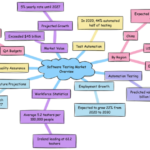
A Quality Assurance Agreement (QAA) outlines rigorous standards, ensuring collaborative efforts in delivering products of unparalleled quality and customer satisfaction.
In the world of software testing, having a quality assurance agreement in place is crucial for streamlining processes and maintaining consistent quality standards.
A quality assurance agreement serves as a contract between businesses and their testing partners, outlining the scope of work, deliverables, timelines, testing methodologies, and communication protocols. By utilizing a well-crafted QAA template, businesses can save time, ensure consistency, and provide a standardized framework for their QA processes.
Key Takeaways:
- A quality assurance agreement is essential for businesses to maintain consistent quality standards in software testing
- By using a template to create a quality assurance agreement, businesses can save time and ensure a standardized framework for their QA processes
- A well-crafted quality assurance agreement includes key elements such as scope of work, deliverables, timelines, testing methodologies, and communication protocols
Understanding Quality Assurance Agreements
A QAA is a vital component of software testing processes for any business. This agreement helps define the scope of work, deliverables, timelines, testing methodologies, and communication protocols that will be followed during testing. By establishing clear guidelines for testing processes upfront, businesses can maintain consistent quality standards and ensure effective communication throughout the testing cycle.
Using a quality assurance agreement template can help streamline the process of creating and implementing this crucial document. A well-crafted template can save time and ensure consistency, providing a standardized framework for QA processes.
Why You Need a Quality Assurance Agreement
A QAA is crucial for any business that wants to ensure the quality of its software products. It provides a clear roadmap for the testing process and helps align all stakeholders on the goals and expectations for the project. Without an agreement in place, businesses may struggle with unclear or changing requirements, ineffective communication, and difficulty in maintaining consistent quality standards.
In addition, QAAs can help businesses mitigate risks and improve project outcomes. By establishing clear expectations upfront, businesses can reduce the likelihood of misunderstandings and errors, improve testing efficacy, and ultimately produce better quality products.
Key Components of a Quality Assurance Agreement
| Component | Description |
|---|---|
| Scope of Work | Defines the specific activities involved in the testing process and the expected outcomes. |
| Deliverables | Outlines the specific items or documents that will be provided during the testing process and when they will be delivered. |
| Timelines | Sets deadlines for each stage of the testing process and defines the overall testing timeline. |
| Testing Methodologies | Defines the testing methodologies that will be followed, such as black-box, white-box, or grey-box testing. |
| Communication Protocols | Outlines the methods and frequency of communication between stakeholders during the testing process. |
By including these components in a quality assurance agreement, businesses can ensure that all parties involved in the testing process are aligned on project goals and expectations.
Key Elements of a Quality Assurance Agreement

A Quality Assurance Agreement (QAA) is a formal document that outlines the responsibilities and expectations of software development teams and QA teams. A well-crafted QAA can help businesses to maintain consistent quality standards in software testing and can provide a standardized framework for QA processes. Here are some key elements that should be included in a QAA:
| Element | Description |
|---|---|
| Scope of work | This should clearly define the project scope, including all features, functionalities, platforms, and devices that will be tested. |
| Deliverables | This should specify the types of documents and artifacts that will be delivered as part of the testing process, such as test cases, test reports, and defect logs. |
| Timelines | This should outline an estimated timeline for the testing process, including milestones and deadlines for deliverables. |
| Testing methodologies | This should detail the testing methodologies that will be used, such as manual testing, automated testing, and exploratory testing. |
| Communication protocols | This should specify the channels and frequency of communication between development teams and QA teams. |
It is important to note that these elements may vary depending on the project requirements and the specific needs of the business. Therefore, it is essential to customize the QAA template to fit individual business requirements.
Benefits of Using a Quality Assurance Agreement Template

Utilizing a QAA template offers numerous benefits for businesses seeking to streamline their QA processes. Here are some of the key advantages:
- Saves time: Creating a quality assurance agreement from scratch can be a time-consuming task, requiring extensive research and consultation. A template simplifies the process by providing a framework for the agreement’s structure and content.
- Ensures consistency: A well-crafted template ensures that all QA agreements adhere to a standardized format and include essential elements. This consistency helps avoid errors and omissions that could negatively impact QA processes.
- Provides a standardized framework: By utilizing a template, businesses can establish a standardized framework for their QA processes. This framework can be customized to meet specific requirements, making it easier to maintain consistent quality standards.
Additionally, templates offer flexibility, allowing businesses to customize agreements to fit their unique needs. Whether it’s incorporating specific testing methodologies or establishing communication protocols, a quality assurance agreement template provides a useful starting point for optimizing QA processes.
How to Craft a Quality Assurance Agreement
Creating a QAA requires careful consideration of various factors. Follow these steps to craft an effective agreement:
- Define the scope of work: Clearly outline the responsibilities of each party involved in the project. This includes the tasks and activities to be carried out, performance expectations, and project timelines.
- Specify deliverables: Describe the expected results of the project and the testing deliverables required at each stage of development.
- Outline testing methodologies: Explain the testing strategies and methodologies to be employed, as well as the tools and techniques to be used.
- Establish communication protocols: Define the channels and frequency of communication between the parties, including reporting procedures, status updates, and issue resolution processes.
- Include clauses for changes: Describe the procedures for making changes to the agreement, including the process of obtaining approvals and the impact of changes on timelines and costs.
- Incorporate legal details: Include clauses that protect both parties, such as confidentiality, termination clauses, and liability limitations.
When crafting a quality assurance agreement, involve the relevant stakeholders from each team to ensure buy-in and alignment.
Utilizing a QAA template can simplify the process and help ensure that no crucial elements are forgotten. Customizing the template to meet specific business needs can ensure that the agreement is tailored to the unique requirements of the project.
Common Pitfalls to Avoid in Quality Assurance Agreements
Creating a quality assurance agreement is an essential step for businesses to ensure consistent quality in their software testing processes. However, there are some common pitfalls that should be avoided to maximize the effectiveness of the agreement.
Not involving relevant stakeholders
It is crucial to involve all relevant stakeholders in the creation of the quality assurance agreement. This includes testers, developers, project managers, and business stakeholders. Failing to include key stakeholders could lead to misunderstandings and disagreements about the scope of work, deliverables, and timelines.
Lacking specificity
The quality assurance agreement should be specific and clear about the expectations and responsibilities of each party. Vague language or ambiguous terms can lead to confusion and disputes down the road. It’s important to define terms such as “defect” or “bug” to avoid misunderstandings.
Overlooking communication protocols
Effective communication is vital for successful software testing. The quality assurance agreement should outline the communication protocols for reporting defects, providing feedback, and discussing issues. Failure to define communication channels and frequency can cause delays and errors.
Ignoring testing methodologies
The quality assurance agreement should clearly define the testing methodologies to be used. This includes acceptance criteria, testing environments, and tools. It’s important to agree on testing methodologies to ensure consistency in testing and avoid rework.
Missing timelines and deadlines
The quality assurance agreement should include a timeline and deadlines for deliverables. This ensures that all parties are aware of the project schedule and can plan accordingly. Delayed deliverables can affect the project’s timeline and budget.
Avoiding these common pitfalls can help businesses create effective quality assurance agreements that streamline their testing processes. By utilizing a quality assurance agreement template, businesses can customize and tailor agreements to their unique needs and ensure consistent quality in software testing.
Tips for Implementing and Enforcing a Quality Assurance Agreement
To ensure the efficacy of a quality assurance agreement, it is essential to implement and enforce it properly. Here are some actionable tips to help you achieve this:
- Communicate regularly and transparently: Establish consistent communication channels to keep all stakeholders informed of progress, milestones, and challenges. Provide regular updates and reports to maintain transparency.
- Monitor and measure compliance: Regularly monitor and track the progress of tasks and deliverables against the agreement’s terms. Identify areas where there are discrepancies and take corrective measures promptly.
- Make compliance part of the culture: Incorporate the quality assurance agreement into the company culture and daily operations. Train staff on the importance of QA and how to comply with the agreement’s terms.
- Use automation and tools: Utilize automation tools and software to streamline and simplify the QA processes. This will help to reduce the incidence of human error and ensure consistency in testing.
By following these tips, you can optimize your quality assurance agreement to achieve consistent and reliable results in software testing. Remember that the key to success is continuous improvement and adaptation. Regularly review and update the agreement to keep pace with evolving business needs and industry standards.
Customizing Your Quality Assurance Agreement Template
Having a quality assurance agreement template is a great way to ensure consistency and optimize your QA processes. However, to fully leverage its benefits, it is important to customize the template to your specific business needs.
Here are some key elements that can be tailored in a QA agreement template:
| Element | Customization Options |
|---|---|
| Scope of Work | Specify the exact tasks and responsibilities of each party involved in the agreement. Ensure that all requirements, deliverables, and timelines are clearly defined. |
| Testing Methodologies | Define the testing methodologies that will be followed. These can include manual testing, automated testing, exploratory testing, regression testing, and acceptance testing, among others. Depending on your needs, you can choose to focus on one or more of these methodologies. |
| Communication Protocols | Outline the communication protocols that will be followed throughout the QA process. Specify the channels of communication, frequency of updates, and escalation procedures in case of issues or discrepancies. |
By customizing your QA agreement template, you can ensure that it accurately reflects your business needs and requirements, making it easier to enforce and implement. This also helps avoid any misunderstandings or disputes that may arise due to unclear or vague terms.
QATPro offers customizable quality assurance agreement templates tailored to your business needs, ensuring that you have all the necessary components to maintain consistent quality standards in your software testing processes.
Conclusion
A quality assurance agreement is a critical document that businesses should have to maintain consistent quality standards in software testing. Utilizing a QA agreement template can streamline the process of creating such agreements and yield multiple benefits.
Customization is an essential aspect of crafting an effective agreement, and businesses should tailor the template to align with their specific requirements. It is crucial to involve relevant stakeholders in the agreement creation process, and it is equally important to implement and enforce the terms effectively.
If you are looking for a reliable partner for software testing outsourcing, QATPro offers a wide range of services to help businesses optimize their QA processes and achieve their objectives. Use a QA agreement template as a starting point to save time and ensure consistency in your QA processes.
FAQ

Q: What is a quality assurance agreement?
A: A QAA is a document that outlines the terms, responsibilities, and expectations for maintaining quality standards in a specific process or project. It serves as a formal agreement between parties involved in the quality assurance process.
Q: Why is a quality assurance agreement important?
A: A QAA is important because it helps ensure consistency, clarity, and accountability in quality assurance processes. It helps define roles and responsibilities, establishes standards and expectations, and provides a framework for effective communication and collaboration.
Q: What are the key components of a quality assurance agreement?
A: The key components of a QAA typically include the scope of work, deliverables, timelines, testing methodologies, communication protocols, and dispute resolution mechanisms. These elements help ensure that all parties involved are aligned and have a clear understanding of their roles and responsibilities.
Q: How can a quality assurance agreement template help?
A: A QAA template can provide a standardized framework for creating agreements, saving time and effort. It ensures consistency across multiple agreements and can be easily customized to meet specific business needs. Using a template also helps establish best practices and ensures that important elements are not overlooked.
Q: How can I customize a quality assurance agreement template?
A: To customize a QAA template, you can tailor the specific language, sections, and clauses to align with your business requirements. You can modify the scope of work, deliverables, timelines, and other elements to reflect your project’s unique needs. Customization allows you to create an agreement that precisely fits your organization’s quality assurance processes.
Q: What are common pitfalls to avoid in quality assurance agreements?
A: Common pitfalls to avoid in QAAs include vague language, inadequate scope definition, unrealistic timelines, lack of clear communication protocols, and inadequate dispute resolution mechanisms. It is important to proactively address these issues to ensure the effectiveness of the agreement and avoid potential conflicts or misunderstandings.
Q: How can I implement and enforce a quality assurance agreement effectively?
A: To implement and enforce a QAA effectively, it is important to establish clear communication channels, regularly monitor adherence to the agreement’s terms, and provide necessary training and support. Regular reviews and assessments can help identify areas for improvement and ensure compliance with the agreement’s requirements.
Q: What is the importance of involving relevant stakeholders in the agreement creation process?
A: Involving relevant stakeholders in the agreement creation process ensures that all perspectives, requirements, and expectations are taken into account. This helps create a more comprehensive and effective quality assurance agreement that captures the needs of all parties involved. It also promotes buy-in and commitment from stakeholders, increasing the likelihood of successful implementation and enforcement.
Joshua, a distinguished technical author and expert in software testing and quality assurance, originated from the dynamic city of London. His journey began at Imperial College London, where his fascination with technology bloomed into a profound understanding of software intricacies.
After graduation, Joshua carved his path at UNESCO, overseeing quality assurance teams and processes with a keen eye for detail. His career then took him to Microsoft and Twitter, where he honed his skills further, leading developments and implementing testing strategies. His efforts were central to enhancing user experiences, as he championed efficiency and innovative methodologies.
Beyond his professional role, Joshua’s dedication extended to educating others. His technical writings, appreciated for their clarity and depth, have significantly influenced the industry.
Despite his remarkable professional achievements, Joshua maintains a balanced life in London, enjoying tranquil retreats with his wife, Tracy, and drawing inspiration from their adventures. His unyielding commitment to excellence in software testing is shaping the technological landscape for future generations.







